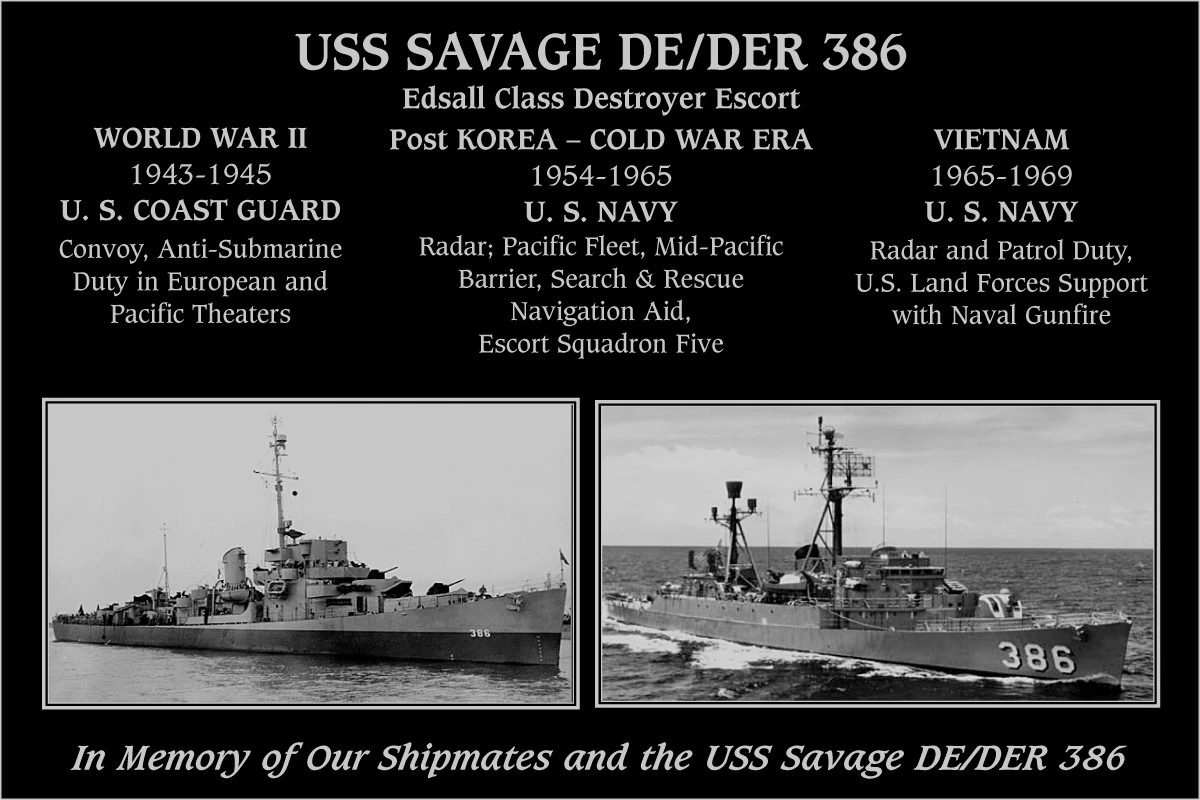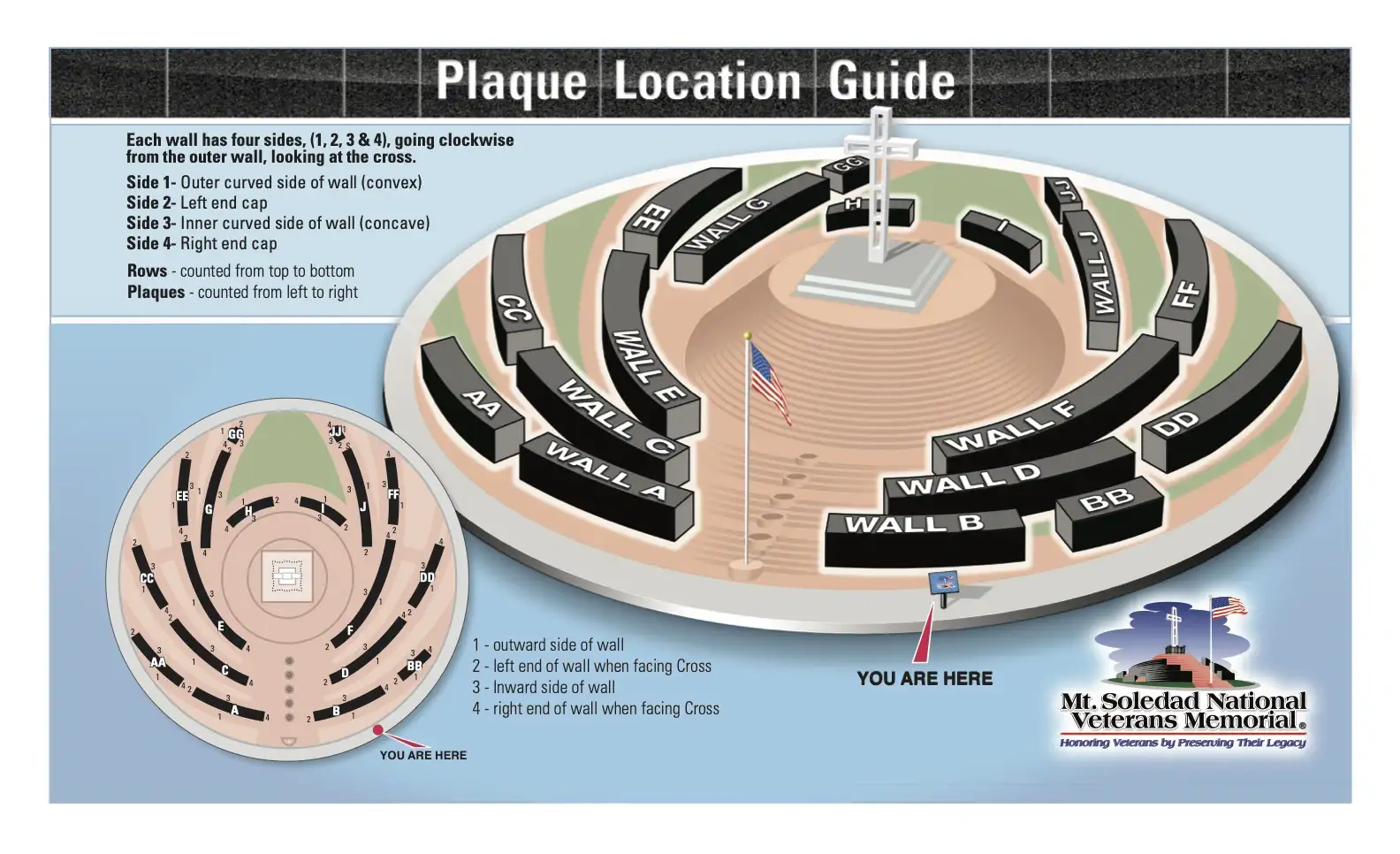USS Savage DE/DER-386

| Era | Cold War |
|---|---|
| Branch | U.S. Navy |
| Wall | G |
| Wall Side | 3 |
| Row | 4 |
| Plaque Number | 38 |
In Memory of Our Shipmates and the USS Savage DE/DER 386
WORLD WAR II
1943-1945
U. S. COAST GUARD
Convoy, Anti-Submarine Duty in European and Pacific Theaters
1954-1965
U. S. NAVY
Radar; Pacific Fleet, Mid-Pacific
Barrier, Search & Rescue
Navigation Aid,
Escort Squadron Five
VIETNAM
1965-1969
U. S. NAVY
Radar and Patrol Duty, U.S. Land Forces Support with Naval Gunfire
USS SAVAGE (DE/DER-386) was an Edsall-class destroyer escort built for the United States Navy during World War II.
Namesake
Walter Samuel Savage Jr. was born on 26 April 1919 in New Orleans, Louisiana. He was commissioned Ensign, United States Naval Reserve, on 10 June 1941. After instruction at the Navy Supply Corps School, Harvard University, Ensign Savage reported to the USS Arizona for duty as Assistant Paymaster. He died on the Arizona during the Japanese Attack on Pearl Harbor on 7 December 1941.
Construction and commissioning
She was laid down 30 April 1943 by Brown Shipbuilding Co., Houston, Texas and launched on 15 July 1943. The ship was commissioned on 29 October 1943 manned by a Coast Guard crew. On 18 November 1943 she was underway for Bermuda, British West Indies, for her shakedown cruise.
Commencing Thanksgiving Day of 1943, the ship was subjected to rigorous training schedule including gunnery practice, submarine warfare tactics, maneuvering, and the hundreds of other tasks demanded of a man-o-war.
On 23 December 1943 she departed for the U.S. Navy Yard in Charleston, South Carolina for post-shakedown repairs.
World War II North Atlantic operations
On Christmas Day, Savage completed her training and ship and crew reported to Norfolk, Virginia as members of the Atlantic Fleet.
In January 1944 the ship was assigned as one of six vessels composing Escort Division 23 of Task Force 63. This task force was engaged in escorting convoys of 60 to 80 merchant ships from United States ports to the Mediterranean Theatre.
During the operations, lasting approximately seven weeks for each convoy, Savage and her sister ships safely escorted hundreds of ships loaded with vital war materials safely past the heavy enemy submarine and air concentrations in the Atlantic and Mediterranean.
On 1 April 1944. Convoy UGS 36, whose escort included USS Savage, was attacked by thirty enemy aircraft north of Algiers, Algeria. So intense was the gunfire of the escorting ships that the attack was repelled without a single allied vessel lost. Her only casualty during the action was a member of the depth charge crew who was struck in the ankle by shell fragments.
During the latter half of 1944 and the first six months of 1945, USS Savage escorted high-speed troop convoys between New York and the British Isles to support the final assault on Nazi Germany.
During eighteen crossings of the Atlantic, Savage and her sister ships safely brought through over 1,000 loaded troop and supply ships without a single loss despite the persistent threat of enemy vessels and treacherous weather conditions,
Following the defeat of Nazi Germany, Savage sailed to the Brooklyn Navy Yard, where she was fitted with more anti-aircraft guns. She then sailed on 30 May 1945 for an intensive period of operational and gunnery training in the Caribbean of Culebra, Puerto Rico.
Transferred to the Pacific theater
After transiting the Panama Canal on 18 June 1945, she proceeded from San Francisco to the Aleutian Islands and arrived at Adak on 8 July 1945. The ship and her crew reported to the Commander of North Pacific Fleets for escort duty.
End-of -war activity
After the hostilities in the Pacific ended, Savage escorted two convoys from Cold Bay, Alaska to Russian waters where the American escort ships were dismissed. One convoy departed Cold Harbor on 23 July 1945 and the other on 25 August 1945. During the interim, she escorted oilers to refuel Task Force 92, which had been bombarding shore installations in the Kuril Islands of Russia; then occupied by Japanese forces.
On 27 September 1945 Savage departed Attu for Petropavlovsk, USSR, and arrived there on the morning of 2 October 1945. She delivered supplies and mail to USS Harry L. Corl then departed for Attu.
At the end of hostilities with Japan, Savage was assigned liaison duty in the Far East. She shuttled between Okinawa, and Tsingtao, China from December 1945 until February 1946 when she sailed for Pearl Harbor.
In April 1946, she sailed for Green Cove Springs, Florida. She was decommissioned there on 13 June 1946; with her CO Captain John M. Waters, USCG in attendance. Also decommissioned at this location in June 1946 were the other five Coast Guard manned ships comprising CortDiv23. Sellstrom, Mills, and Richey. With the exception of Richey, all were recommissioned as Navy manned destroyer escort radar picket ships.
Conversion to radar picket ship
After World War II most, if not all, early warning networks had been dismantled. At the height of the Cold War, paranoia ran deep within the halls of the United States military establishment. By 1949, the USSR had developed the atomic bomb and the capacity to deliver it by air. The United States considered that it needed to protect itself from the Soviets, formerly allies. To this end, the US constructed early-warning stations. This system was called the Distant Early Warning system or the DEW Line, which was a state of the art product.
There were 22 stations and the line spanned approximately 3,693 miles (5,943 km). The DEW Line’s radar stations could chart the path of the Soviet bombers toward the North American continent. It was hailed as “a bulwark” against the forces of communism. Radar picket escort destroyers were employed to detect these aircraft moving toward North America on a polar route.
Plaque Wall Map

